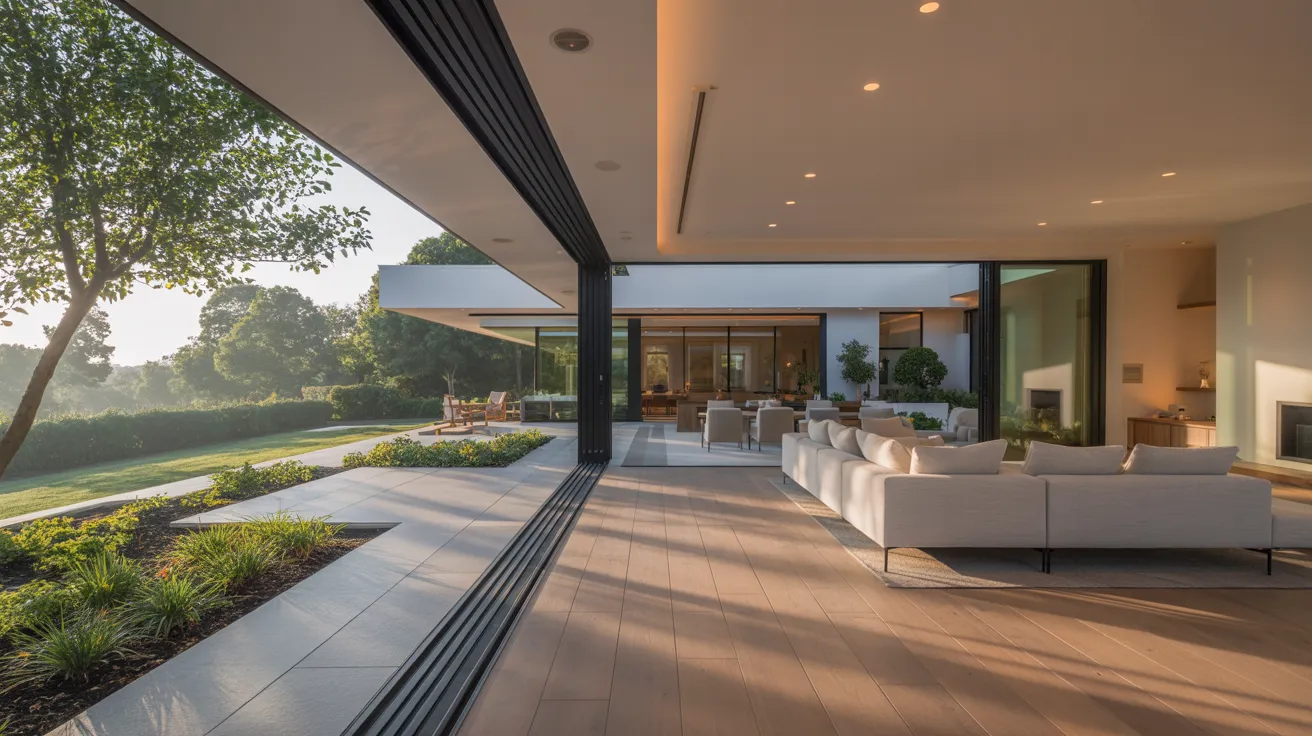You'll find that premier architect projects in Atlanta, Decatur, and Brookhaven feature sustainable mixed-use developments, inventive modern homes, and sensitive historic preservation. You'll see open-plan interiors with refined materials, adaptive reuse that honors industrial history, and sustainable features including native plants and solar technology. Acclaimed commercial and community buildings stand out for material innovation, daylighting, and integration with their communities. You'll find a remarkable combination of architectural vision and technical prowess—explore further, and you'll discover how these projects establish new standards.

Essential Points
Stunning Residential Developments in the Heart of Decatur
In what ways do contemporary architects redefine residential living in Decatur? You'll notice a clear movement toward open floorplans that optimize spatial flow and natural light. By eliminating traditional barriers, you design multifunctional living areas that encourage both connectivity and privacy. Architects incorporate minimalist interiors, opting for refined materials like smooth concrete, glass, and natural wood. You'll discover built-in storage solutions and integrated lighting, which decrease visual clutter and amplify clean lines. Large windows and sliding doors merge boundaries between inside and out, creating a seamless connection with landscaped courtyards or patios. Every detail, from sleek storage units to hidden fixtures, maintains a streamlined aesthetic. By focusing on open floorplans and minimalist interiors, you set a new residential standard: one that balances efficiency, comfort, and sophisticated design.
Atlanta's Historic Preservation Projects
Various historic preservation projects around Atlanta showcase architects' commitment to revitalizing the city's notable structures while maintaining their original character. You'll see a meticulous approach when tackling preservation problems such as physical decline, deteriorating elements, and code compliance. Architects employ specialized restoration approaches—renovating brickwork, recreating period-appropriate windows, and reinforcing historic facades—to ensure both endurance and originality. Every alteration is thoroughly documented, from the choice of historically accurate materials to the addition of modern building systems that preserve visual integrity. It's essential to also reconcile energy efficiency with preservation mandates, often requiring creative problem-solving. These efforts allow Atlanta's historic landmarks—churches, theaters, and antebellum homes—to accommodate future generations, blending technical expertise with a sincere respect for architectural heritage and urban context.
Green Building Practices in Brookhaven
You'll notice Brookhaven's leading projects focus on sustainable construction materials that minimize environmental impact without sacrificing performance. Incorporate energy-saving design solutions to reduce operational costs and enhance occupant comfort. Integrate sophisticated water conservation techniques, ensuring every system supports long-term sustainability.
Eco-Friendly Construction Materials
What sets sustainable architecture in Brookhaven unique is its devotion to innovative green building materials that reduce environmental impact without sacrificing structural integrity or aesthetics. You'll notice architects here strategically select materials like recycled steel, valued for its durability and reduced embodied energy compared to conventional steel. Recycled steel's resilience provides lasting frameworks while supporting eco-conscious design. Moreover, integrating solar panels directly into building envelopes not merely generates clean energy but also creates sleek, modern rooflines. You receive high-performance insulation and responsibly sourced wood, each chosen for eco-friendly properties and sustainable qualities. When you emphasize these innovative materials, you help design spaces that appear refined and function optimally, all while minimizing your carbon footprint and guaranteeing your project achieves the highest sustainability standards.
Eco-Friendly Design Strategies
Energy-efficient design solutions and material choices define sustainable architecture in Brookhaven by maximizing efficiency throughout the process. The key is implementing solar integration, carefully placing photovoltaic panels to maximize energy capture without compromising the building's form. Position windows and living spaces to capture natural daylight, reducing reliance on artificial lighting. Utilize deep roof overhangs and fixed shading devices to control heat gain. With passive cooling strategies, like strategic ventilation, thermal mass integration, and operable high windows, you'll maintain interior comfort while limiting mechanical cooling demands. Incorporate high-performance insulation and airtight building envelopes to prevent thermal bridging and energy loss. Every detail, from the orientation of glazing to the application of advanced HVAC zoning, contributes to a holistic, energy-efficient outcome optimized for Brookhaven's climate.
Water-Saving Techniques
Even though Brookhaven's rainfall patterns vary throughout the year, integrated water conservation approaches are crucial for sustainable architecture. You should prioritize rainwater harvesting systems, which collect runoff from rooftops and store it for irrigation or other non-drinking purposes. Implement bioswales, cisterns, and permeable surfaces to channel and filter stormwater, decreasing both runoff and demand on municipal supplies. Xeriscaping landscaping helps decrease water consumption—replace traditional turf with drought-tolerant native species, mulch beds, and targeted watering solutions. Pick hardscape materials that enable natural drainage rather than runoff. Consider water-efficient fixtures and water-saving toilets throughout the project. By incorporating these components, you'll establish buildings that respect Brookhaven's natural hydrology while reaching long-term sustainability through lower water usage and thoughtful property maintenance.
Exceptional Commercial Environments
Although the commercial sector calls for both utility and visual aesthetics, award-winning spaces set themselves through cutting-edge use of components, layout strategies, and eco-friendly practices. When you step inside such a structure, you instantly see how landscaping aesthetics complement the architecture, channeling movement and creating natural indoor-outdoor transition. Every element, from native plant palettes to porous hardscaping, is chosen to improve not just exterior aesthetics but also sustainability. Inside, remarkable interior design maximizes ambient lighting, adaptable spaces, and acoustic treatments to improve performance and comfort. You'll find that material decisions emphasize durability and eco-consciousness, while color schemes and finishes support brand presence. This meticulous attention to detail creates commercial environments that are both visually striking and operationally optimal, creating new industry standards.
Innovative Building Repurposing Projects
As designers approach adaptive reuse, they reimagine outdated structures into functional, high-performance environments that respect a building's original character. You'll notice this methodology in projects that convert old industrial spaces, historic buildings, or religious structures into lively commercial spaces, art venues, or living quarters. Adaptive reuse demands a thorough assessment of current infrastructure, building envelope, and foundational elements. You must manage code compliance and implement modern building systems without diminishing the historic fabric. Precise execution is vital—think exposed brick combined with sleek glazing or restored timber beams supporting open-plan workspaces. Through intelligent space transformation, you maximize usable area, upgrade energy performance, and deliver contemporary functionality within a heritage context. The result? Projects that successfully merge sustainability with forward-thinking approaches, enhancing community value and architectural significance.
Forward-thinking Integrated Urban Spaces
As urban areas become denser and metropolitan real estate grows more limited, mixed-use developments provide architects with possibilities to design complex, multi-programmatic environments that benefit from synergy. Architects must balance retail, residential, office, and recreational functions within a single footprint, maintaining seamless circulation and spatial hierarchy. Strategic metropolitan design calls for careful examination of the site context, incorporating efficient transportation linkages, pedestrian pathways, and public spaces. Zoning regulations dictate essential parameters—height limits, setbacks, parking requirements—that demand innovative design solutions to optimize density without sacrificing livability. Designers must include sustainable materials, daylighting strategies, and energy-efficient systems to boost performance and user experience. By prioritizing connectivity and accessibility, architects can develop vibrant, resilient communities that respond to evolving urban needs and advance architectural excellence.
Iconic Public and Cultural Buildings
Beyond the complexities of mixed-use developments, you'll encounter public and cultural buildings demanding a heightened sensitivity to local identity, symbolism, and social context. When handling these projects, evaluate the interplay between site, form, and function. You must acknowledge the weight of cultural landmarks; they must integrate seamlessly into their urban fabric while maintaining iconic presence. Building materials, natural light, and space planning are essential, guaranteeing visitor flow and accessibility are enhanced. Public art installations should be thoughtfully chosen, serving both as focal points and as catalysts for community engagement. You'll need to balance contemporary design with respect for historical narratives, creating environments that encourage reflection and interaction. In Atlanta, Decatur, and Brookhaven, such buildings ultimately elevate civic pride and reinforce a city's distinctive identity.
Questions & Answers
What's the Best Way to Select an Architect for My Project?
While choosing the ideal architect for your project, you'll want to review their expertise with your chosen architectural style and analyze their design portfolio for precision and accuracy. Prioritize architects who prioritize client collaboration—ask about their methodology for including your input in design decisions. Review their precision in previous projects, and ensure they communicate clearly about construction phases, timelines, and budgets. This method helps guarantee a well-coordinated, successful project outcome.
How Long Is the Typical Schedule for a Building Design Project?
As you start an architectural project, you'll advance through various project phases, each with its own timeline. Typically, the design processes—consisting of conceptual design, schematic design, and design development—take three to six months, depending on complexity. Creating construction documents takes a further two to four months. The permitting process varies, typically taking one to three months. The building process can last six months to twelve months or longer. Maintain close communication with your architect to decatur top architect make sure each phase satisfies your project's requirements and timeframe.
What's the Cost of Architectural Services in Atlanta?
When you're ready to begin your project, it's important to note that hiring an architect in Atlanta typically runs 8-15% of your overall construction or renovation budget. The fee varies based on architectural styles, project complexity, and the extent of services you require. For a renovation, the cost ranges anywhere from $5,000 for basic services to over $50,000 for premium projects. Always discuss project details and expectations at the beginning to prevent unexpected issues.
What Required Permits Must Be Obtained Before Construction
Prior to starting the construction process, you must secure multiple permits. Generally, you need to get a building permit, which ensures your plans adhere to local building codes and zoning regulations. Depending on your project's scope, you may also require permits for electrical, mechanical, and plumbing work. Be sure to provide detailed architectural drawings for approval. Verifying your design meets zoning requirements, such as setbacks and height restrictions, helps you avoid costly revisions or delays in your construction timeline.
Do Architects Offer Interior Design Services Also?
Architects absolutely can contribute to interior design. You'll appreciate their technical precision and creative perspective, confirming interior aesthetics integrate perfectly with the architectural design. When you engage an architect, you develop creative cooperation between structural features and interior spaces. They'll select materials and design elements, coordinating every detail for a cohesive look. By incorporating interior design from the start, you maximize both aesthetics and functionality throughout your space.
Final Thoughts
While discovering Atlanta's distinctive communities, you'll observe how leading designers combine form and function—over 60% of Atlanta's recent projects feature sustainable design elements. One can observe careful consideration in each development and restoration effort. Whether it's maintaining traditional character or designing contemporary spaces, these projects challenge conventions and establish benchmarks. When you walk these streets, you're experiencing a city defined by creative design, professional skill, and architectural innovation.
 Devin Ratray Then & Now!
Devin Ratray Then & Now! Destiny’s Child Then & Now!
Destiny’s Child Then & Now! Jenna Von Oy Then & Now!
Jenna Von Oy Then & Now! Raquel Welch Then & Now!
Raquel Welch Then & Now! Ricky Schroder Then & Now!
Ricky Schroder Then & Now!